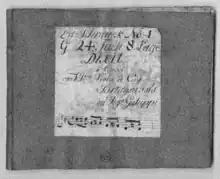
Antonio Vivaldi composed three settings of the Dixit Dominus (The Lord said [unto my Lord]), the Latin version of Psalm 110. They include a setting in ten movements for five soloists, double choir and orchestra, RV 594, another setting in eleven movements for five voices, five-part choir and orchestra, RV 595, and a recently discovered setting in eleven movements for five soloists, choir and orchestra, RV 807, which had been attributed to Baldassare Galuppi. It is said to be one of his "most significant sacred works."
History
There are three recorded compositions of Dixit Dominus – Psalm 110 in Latin (or Psalm 109 in the Vulgate) – by Vivaldi. Each is an extended setting of the vespers psalm for five soloists, choir and orchestra; one only having been identified as his work in 2005.[1][2]
Psalm 110 is regularly included in Vespers services, usually as the opening psalm. Dixit Dominus has been said to be one of his "most significant sacred works".[1]
RV 594
Vivaldi's best-known setting, catalogued as RV 594, is structured in ten movements, eight psalm verses and two movements for the doxology. It is set for soloists, double choir and orchestra.[3] Set in D major, it is scored for two sopranos, alto, tenor and bass soloists, two SATB choirs and orchestras.[3] The first choir (Coro I) is accompanied by two oboes, two trumpets (with timpani), two violins, viola, organ and basso continuo, while the second choir (Coro II) is accompanied by strings, organ and continuo.[4] The duration is given as 25 minutes.[3]
Carus-Verlag published a critical edition in 2005. The ten movements are:[4]
- Dixit Dominus, Allegro, D major, common time, double choirs, orchestras with two organ soloists
- Donec ponam inimicos tuos, Allegro, B minor, common time, two choirs, strings
- Virgam virtutis tuae, Andante – Allegro molto, D major, common time, two sopranos, strings
- Tecum principium, Andante, E minor, 3/4, alto, strings
- Juravit Dominus, Presto, C major, common time, double choir, strings
- Dominus a dextris tuis, Allegro, C major, common time, tenor and bass, strings
- Judicabit in nationibus, Largo, D minor, common time, double choir and orchestras
- De torrente, Andante, E minor, common time, soprano, strings
- Gloria Patri, Allegro, D major, common time, double choirs, orchestras with two organ soloists
- Sicut erat in principio, Allegro D major, common time, double choirs, orchestras
RV 595
The setting discovered next was catalogued as RV 595. Also in D major, it is structured in eleven movements, eight psalm verses and three movements for the doxology. It is scored for two sopranos, alto, tenor and bass soloists, a choir which also calls for divided soprano in some movements, and an orchestra comprising strings, two oboes, trumpet, and continuo bass.[1]
The eleven movements are:[1]
- Dixit Dominus Domino meo, D major, common time, choir, strings, oboes and trumpet, continuo bass
- Donec ponam inimicos tuos, D major, 3/4, choir and orchestra
- Virgam virtutis tuae, G major, common time, soprano solo, strings, continuo bass
- Tecum principium, A minor, 3/8, two soprano solos, two cellos, continuo bass
- Juravit Dominus, E minor/G major, 3/2, choir, strings, continuo bass
- Dominus a dextris tuis, B minor, common time, soprano solo, strings, continuo bass
- Judicabit in nationibus, D major, common time, choir, strings, trumpet, continuo bass
- De torrente in via bibet, E minor, common time, alto solo, strings
- Gloria Patri, et Filio, D major, 3/8, alto, tenor and bass solos, continuo bass
- Sicut erat in principio, D major, common time, choir, strings, oboes and trumpet, continuo bass
- Et in saecula saeculorum, D major, 3/4, choir, strings, oboes, continuo bass
RV 807
The Vivaldi setting catalogued as RV 807 was identified as his work only in 2005, having been thought to have been written by Baldassare Galuppi.[2] A handwritten copy held by the Saxon State and University Library Dresden (Sächsische Staatsbibliothek) in Dresden is titled "Dixit a 4: con strumenti / del Sig: Baldasar Galuppi, detto Buranello / Fatto per l'Ospedale delli Mendicanti / 1745".[5] Set in D-major, it is scored for two sopranos, alto and two tenor soloists, choir and an orchestra of two bassoons, trumpet, strings and continuo.[5] A reviewer of its first recording described it as a masterpiece with "bold, intensely coloured rhetoric".[2]
References
- 1 2 3 4 Talbot, Michael (1997). Dixit Dominus, RV595. Hyperion Records. Retrieved 20 October 2018.
- 1 2 3 Vickers, David (August 2006). "Vivaldi Dixit Dominus; Galuppi Laetatus sum". Gramophone. Retrieved 20 October 2018.
- 1 2 3 "Antonio Vivaldi / The Lord said unto my Lord / RV 594". Carus-Verlag. 2005. Retrieved 14 October 2018.
- 1 2 Hofmann, Klaus (2005). Dixit Dominus / in due cori / RV 594 (PDF). Carus-Verlag. pp. 1, 3. Retrieved 14 October 2018.
- 1 2 Dixit Dominus in D major, RV 807 (Vivaldi, Antonio): Scores at the International Music Score Library Project
Editions
- Vivaldi: Dixit Dominus, RV 594, Carus-Verlag 2005
External links
- Free scores by Dixit Dominus, RV 594 (Antonio Vivaldi) in the Choral Public Domain Library (ChoralWiki)
- Free scores by Dixit Dominus, RV 595 (Antonio Vivaldi) in the Choral Public Domain Library (ChoralWiki)
- David Vickers: Vivaldi Dixit Dominus Gramophone 2009
- Dixit Dominus, RV594 Hyperion Records
- Dixit Dominus, RV595 Hyperion Records